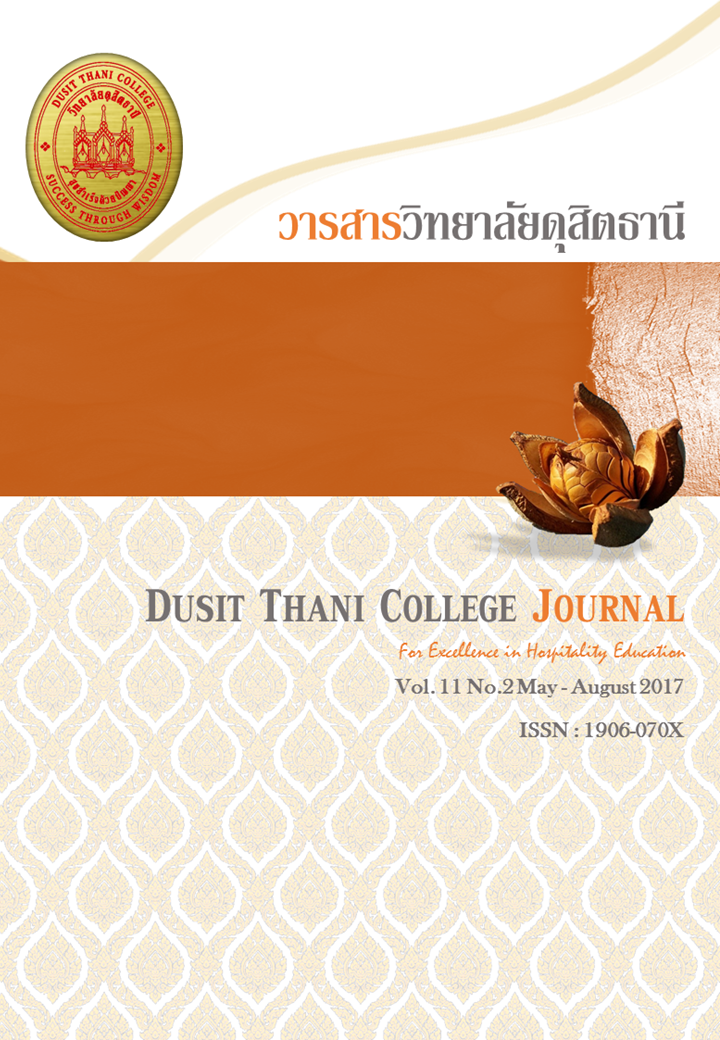Potential of Tourism Resources in Udon Thani Province
Main Article Content
Abstract
The objectives of this research were 1) To study the strengths weaknesses opportunities and threats of the environment integrated sustainable Udon Thani province. 2) to study circumstances and Improve of integrated tourism development for sustainable in Udon Thani Province; and 3) to evaluate the potential of tourism resources in Udon Thani Province. It’s mixed with a qualitative research and a quantitative research. The qualitative method was conducted by studying documents and intensive interview relating people in 10 important tourist attractions. These 3 groups of interviewee were 1) government officials 2) private sectors and 3) the locals in the tourist attractions. The quantitative method was conducted by studying satisfaction of foreign and domestic tourists visiting Udon Thani Province to study Potential tourism development in Udon Thani Province.
The analysis of the survey data identifies that for the background of tourists, a large proportion of them are women, aged 20-29, single, got Bachelor Degree, own private business, earn 20,000–29,999 baht per month. For the behavior, a large proportion of tourists traveled with their friends, has been to Udon Thani Province, traveled by car, at the weekend, one day trip, traveled for recreation, searched the travel information on the internet, and spent 1,000-3,000 baht. Over half said they were going to visit Udon Thani Province again. For the potential of tourism resources evaluation, it is evident that satisfaction is the highest mean score of 4.11. When considering score of each aspect, it found that all of them are high; activity, culture and history, nature, exhibition and festival, and service from highest to lowest, respectively. For the factors of tourism marketing, it is evident that satisfaction is the highest mean score of 4.39. When considering score of each aspect, it found that all of them are high; physical appearance, distribution, personnel, process, promotion, and product from highest to lowest, respectively. Co-operation of all relating sectors to develop the potential of tourism resources for sustainable in Udon Thani Province was also emphasized to plan developing the potential of tourism resources such as activity, culture and history, nature, exhibition and festival, and service to lead to sustainable tourism development.
Article Details
Article Screening Policy
- All research and academic articles to be published must be considered and screened by three peer reviews in the relevant field / article.
- All articles, texts, illustrations and tables published in the journal are the personal opinions of the authors. Editors don't always have to agree. And no responsibility whatsoever is the sole responsibility of the author.
- The articles to be published must never be published. Where did you first publish? And not in the consideration of other journals If the audit found that there has been a duplicate publication It is the sole responsibility of the author.
- Any article that the reader sees as being plagiarized or impersonated without reference. Or mislead the work of the author Please let the journal editor know it will be your greatest blessing.
References
DoungJit, Chanwit. (2015). Discover Thainess. http // : tatnewsthai.org/detail.
php?newsD=3759 Searched on April 30.
Podhisita, Chay. (2013). Qualitative research. Edition 6. Bangkok: Amarin Printing Software. Advertising & Publishing.
Wibulsanti Chupen, (2011). Analysis of strengths, weaknesses, opportunities and threats (risks). Enterprise (SWOT Analysis). On December https://www.pharmacy. cmu.ac.th/pharmcare/pharad/swot 982.htm.
Khumphet, Kemmika. (2012). The Tourism Development Payam Ranong by Participation Community tourism Naresuan. The independent study MA, hotel management and tourism, university.
Chareonwongsak, Kriengsak. (2003). Integrative Thinking (No. 4). Bangkok: Success Media.
Silanoi Laiard, (2015). Methodology for determining sample quantitative research. Bangkok: Publisher Bangkok blueprints Limited.
Mattekaronjit Matte, (2013). Development strategy: from theory to practice proactive. Nonthaburi: Book Point Academic.
McIntosh, Robert W ; Goelder, Charles R ; & Ritchie, J.R. Brent. (1995). Tourism Principles, Practices, Philosophies. USA.
Robbins,S.P.,& Coufter,M. (2002). Mznagement. 7thed. New Jersey: Prentice-Hall International.
Ministry of Tourism and Sports. (2012). Tourism Strategic Plan of 2554-2558. Bangkok.
Ministry of Tourism.
Office of the National, (2012).Economic and Social Development ; National Economic
and Social Development Plan National No. 11 of 2555 -2559. The Prime Minister.
Tampateep Pajit, (2006). Strategic planning,development for eco-tourism sustainable.
Chainat BS. M. Bangkok: Graduate School.University Press.
Dhamabutra Payom, (2006). Documents for teaching about participation. Local communities in tourism development. Bangkok: Institute of Ecotourism development. University Press.
Khunpalin Phuwanida, (2012). Tourism Strategy of Development Administration, Bangkok. Integrated. Ph.D. philosophy Branch Administration, College Ramkhamhaeng University.
Wutayapatheerakun, Sunsanee (2008). The standard tour Enhance the quality of tourism offices Tourism: Tourism Ministry.
Chandawanich Suprank, (2013). Qualitative research methods. Edition 21 Bangkok:
Chulalongkorn. University.
Suriwong Surin, (2010). Shape of tourism at Lum Manumdang. The Chiang Mai A sustainable tourism. Dissertation Doctor of Philosophy of Development Tourism University.
Thailand Institute, (1999). of Scientific and Technological Research. The final report.
Implementation of policy for ecotourism. OR (2). Bangkok: Thailand Institute of Scientific and Technological Research.
Wertheim, W.F. (1981). The Urgency Factor and Democracy : a theorical contribution to
Unrisd’ debate on participation. Geneva: UNRISD.


